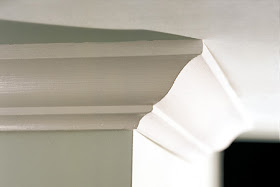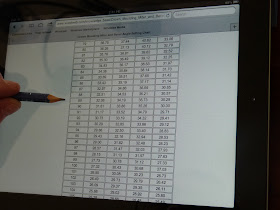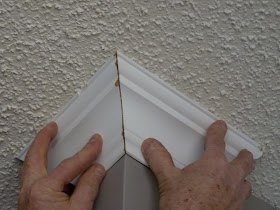 |
| Image from: thisoldhouse.com |
Crown molding is the decorations on the icing on the cake, and finishes off a space or object with beauty and elegance. It looks like it should be simple to do - but it's not. I painfully discovered this the first time I tried to do it myself to finish off the kinda-custom storage cabinet I made awhile back. The problem is that unlike baseboards or other trim you may use in your home crown molding involves cutting compound angles which gets, well . . . mathy. Some people try to avoid this by cutting simple casing or baseboard and place it around the top of a room the same way they would the bottom - but it's just not the same. The beauty of crown molding is not only the way it caps off the top of a wall or object, but the way it projects outward creating beautifully extending lines and shapes.
Crown molding should lean out from the wall or object as illustrated in this diagram from rockler.com which creates a "spring angle." You have to keep this angle in mind as you cut the angles to get around the corners of your wall or object.
I wish there was a really simple, fail-proof way to cut crown-moulding, but as far as I know there isn't really. I've heard that a more simple way to do it is by creating or purchasing a crown molding jig which will hold your crown molding in it's angled position while you use your mitre saw to cut it, but I've never been able to get my hands on one of these, and really don't know how to use it properly.
 |
| Crown molding jig. |
I had to figure it out the mathy way. Now, I've never been much of a mathy person, but luckily I had my Dad (a math teacher by profession and DIY carpenter on the side) to walk me through how to do this as we installed some crown-molding around the fireplace pop-out we recently created in my living room.
TOOLS & MATERIALS:
- Crown Moulding (enough for what you will need plus extra for test pieces)
- Mitre Saw (that can cut compound angles)
- Measuring tape
- Angle measuring tool
- Pencil
- Square
- Brad-nailer & air-compressor
- Sanding block
- DAP
- Paint
- An extra pair of hands
- Lots of patience
PROCEDURE:
You'll want to pick up an angle-measuring tool to help you precisely measure the angles - here's 2 we used:
STEP 1: Measure
Hold your angle-measuring tool around the corner your need to cut around in order to measure it.
Once you have identified the exact angle of your corner - you'll want to find it on a chart like this one from woodweb.com:
In this instance the corner on my wall was measuring as a 89 degree angle - so in the left hand column of the chart we located 89 degrees, and then we read across the row to discover the mitre angle (35.73) and the bevel angle (30.28) that we needed to cut an 89 degree angle.
OK, so what does that mean?
The "bevel angle" is the angle at which you are going to set the top of your saw (the blade part), the "mitre angle" is the angle at which you are going to set the base of your saw (the bottom part).
So, to cut my 89 degree angle, we set my mitre angle (bottom part) at 35.75 like so:
 |
| To get 35.75 did require a little bit of estimating, because the settings on my saw aren't quite that precise. |
 |
| Again, a little bit of guess-work had to happen here. |
So with my saw now looking like this:
STEP 2: Cutting
You're going to want to cut small test pieces first to check all your measurements before you do the real deal. Make sure you have extra crown molding for this purpose.
With your saw blade locked in position, hold your piece of crown molding firmly against the saw-bed (making sure that it is flat and flush with the back edge) and make the cut! Put this piece to the side.
To get the opposite piece - leave your saw blade in it's position and flip the crown molding over so that it is back-side up. Hold it firmly against the saw-bed (making sure that it is flat and flush with the back edge) and make the cut!
Check your pieces by holding them together to make sure that they fit and are lined up the right way:
STEP 3: Making Adjustments
Check your test pieces on your corner:
As you can see - it's not quite right! If this happens to you - first double check all of your measurements and settings to make sure that you didn't make a mistake somewhere along the way. Also check to make sure that you are holding the pieces of moulding so that they are perfectly flush with your edges (because that will make a difference too) If everything is right - why do you have this problem like we did? Because cutting crown moulding is a pain-in-the-rear, finicky business and there is not a huge margin of error to work with! Remember how we had to do some guess work to find the setting on my saw? That probably made the difference!
How to fix this:
In order to get the tips of your crown-moulding together on the corner, re-adjust your measurements to cut for a smaller angle.
In this case we cut for a 89 degree angle, so we're going to readjust our measurements and cut our test pieces for a 88 degree angle and see how that works. If you've still got a gap at the corner, readjust and cut your test pieces for an 87 degree angle and so on until the corner fits together like so:
STEP 4: Cutting The Real Deal
Now that you have just the right angle worked out with the your test pieces, you're ready to cut the real deal!
A) First measure the length that you will need your piece of crown moulding to be (again preciseness is imperative!):
B) Make your first cut at the end of a length of moulding the same way you cut your first test piece, using your saw which should be left in the same position.
C) Mark the base of the angle with a pencil and square and use this as your point to measure from:
Measure and mark the appropriate length on the moulding, remembering to be as precise as possible!
D) To cut the other end, flip the moulding over so it is back-side up, and cut the angle about 1 inch over your mark.
E) 1 cut at a time, very carefully gradually shave away at the excess until you are right at your mark:
Why bother with all this fuss? Why not just cut it right on the mark the first time?
If you are super-skilled and you think you can do it perfectly on the first shot - go for it! But, again, because crown moulding has to be done soooo precisely - if you cut it too short even by the tiniest amount - you will have wasted your entire length of moulding, so it is much safer to do it this way.
F) Check to ensure that you have cut your piece accurately by holding it up on the wall where it is supposed to go.
G) Repeat this process with the other pieces you will need:

STEP 5: Dry-fitting
All your pieces have been cut, and they should all be right - BUT, just to make sure before you secure them in place you'll want to hold them in position see how they fit together:
STEP 6: Secure In Place
If everything fits just right - go ahead and secure the moulding in place with a brad-nailer.
You can use a sanding block to gently sand down the protruding edge to the shape of the moulding like so:
STEP 7: Finishing off
Fill any cracks and nail-holes with DAP (see my post on "Painting Furniture" for more on how to do this), and finish off with a top-coat of paint!

.JPG)



























.jpg)



O my gosh! It looks beautiful! Also complicated but definitely worth it! Love the stenciled wall too.
ReplyDeleteBrie @ Breezy Pink Daisies
Hi! Just wanted to pop by and let you know your blog was featured on this week’s Wednesday Weekly Review #23! (http://blueeyedbeautyblogg.blogspot.com/2013/03/wednesday-weekly-review-23.html) Congrats!! Be sure to stop by ad grab an I was Featured Button!! (http://blueeyedbeautyblogg.blogspot.com/p/grab-button.html)
ReplyDeleteHelen
Blue Eyed Beauty Blog
Exercise Encouragement Group Blog
P.S. this looks fantastic! Great job!!
I love this! I will definitely do this in my apartment when it will be mine :)
ReplyDeleteMelanie ♥ ~ www.shabby-memories.blogspot.fr
Is that asbestos on your roof?
ReplyDeleteIt is a popcorn ceiling, but my house was built in 1984, after the period when asbestos was commonly used in popcorn ceilings (1950s-1970s - banned in the US in 1978). Still not my favourite ceiling, but such a pain to change. We may do it at some point, but there are many other things I want to change first!
DeleteI like the Step by step method of crown molding for the fire place. I will use this for Crown molding my fireplace.
ReplyDeleteInstall Crown Molding
Why didn't you take the popcorn ceilings off while you were up there?
ReplyDeleteHahaha - I would have loved to! However the ceiling extends through most of the 2nd floor of my house, and we just weren't ready to take on that much work at this time - so the popcorn ceiling is tolerated, for now . . .
Delete
ReplyDeleteValuable information and excellent design you got here! I would like to thank you
for sharing your thoughts and time into the stuff you post!!Bathroom Remodeling Davie
Just remember, upside down and backwards. Use wood filler for mistakes. NO one will notice. I tape my cuts so that the wood doesn't splinter.
ReplyDeleteIt was wondering if I could use this write-up on my other website, I will link it back to your website though.Great Thanks. crown moldings
ReplyDelete